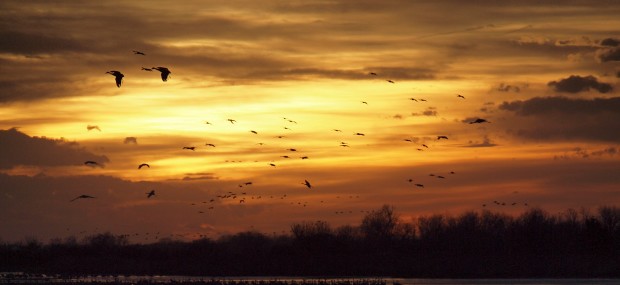We have much more to do and your continued support is needed now more than ever.
Sandhill Cranes: an Ancient Bird, a New Threat, and How You Can Help
If you’re looking for one of the most spectacular migrations in the world, the word “flyover state” takes on a much nicer meaning. Every March, a half million Sandhill cranes converge on the Platte River valley in central Nebraska, where they feast for weeks to build strength for the long migration north. In mid-April they rise in enormous flocks and leave for summer grounds in northern Canada and as far away as Siberia. The phenomenon been going on like clockwork for millennia, drawing bird watchers from around the world who want a glimpse of these and other animals like the critically-endangered Whooping crane.

The Sandhills, in turn, are a unique landscape: 20,000 square miles, part desert, part grassland, with lakes and wetlands scattered throughout. Formed after the last Ice Age by winds that steadily built the dunes as high as 400 feet, the Sandhills are now stabilized by native grasses that allow farmers and ranchers to make a good living there. It is home not just to ranchers and cranes but also pronghorn antelope, porcupines, elk and bison, along with hundreds of other wildlife and plant species.
Making all this possible is a vast underground reservoir — the Ogallala aquifer — that sits beneath the Sandhills. It is our biggest water reserve, providing 30% of the groundwater used for irrigation in the entire US and drinking water for millions of Americans, and at some places the water table is so high that it’s actually at the surface, creating those lakes and wetlands. The Ogallala enabled the Great Plains to become “America’s bread basket,” but overuse threatens to suck this vital resource dry and now Big Oil (always eager to kick Mother Nature when she’s down) has raised the stakes for farmers and cranes alike.
Big Oil’s Dangerous Gamble

The Global Labor Institute at Cornell University has concluded that spills from pipelines of tar sands-derived oil are three times as likely to occur per mile as spills of crude oil. And when they do, the researchers say, the damage is greater, the public health risks larger, the clean-up harder, the costs higher.
A spill over the aquifer would be a disaster. After a local and national outrcry — including criticism from Nebraska’s Republican governor and senators from both parties — sent Keystone XL back to the drawing board, the company has recently proposed another route. But the revised project still crosses the Ogallala aquifer, and critics charge that the “official” border of the Sandhills is a pretty meaningless distinction, because the surrounding area is similar geologically. In other words: new route, same risks.
Double Trouble in the Boreal Forest

Stretching across the northern reaches of our continent, this ecosystem is one of the most important you’ve (probably) never heard of, not just for its striking range of biodiversity but also for the crucial role it plays in regulating our climate: globally, boreal forests — almost a third of which are in Canada — store more carbon than any other biome.
Calling it simply a forest is a little misleading, though — the region also includes vast wetlands like the delta of the Peace and Athabasca rivers in northeastern Alberta, a favorite nesting area for sandhill cranes and hundreds of other species. But danger is on the horizon: just to the south of this vibrant delta, the oil industry is building the biggest industrial project in our planet’s history.
Big Oil’s wholesale demolition of the boreal forest is well-documented but mostly overlooked outside of Canada. (It’s worth checking out these photos to get a sense of the scale and what we’re fighting to protect.) Taken together, habitat loss, catastrophic spills, and climate change pose an enormous risk to sandhill cranes, caribou, wolves and other wildlife, and pipelines like Keystone XL are the key to the whole system. Thanks to a grassroots uprising we’ve halted this project so far, but we need your help to hold the line against tar sands.
![]() Speak up now and tell the Obama Administration to say NO to Keystone XL tar sands oil pipeline. Our planet deserves better.
Speak up now and tell the Obama Administration to say NO to Keystone XL tar sands oil pipeline. Our planet deserves better.





















